Ironwood Tree: Facts, Leaves, Flowers, Bark (Pictures) – Identification and Care
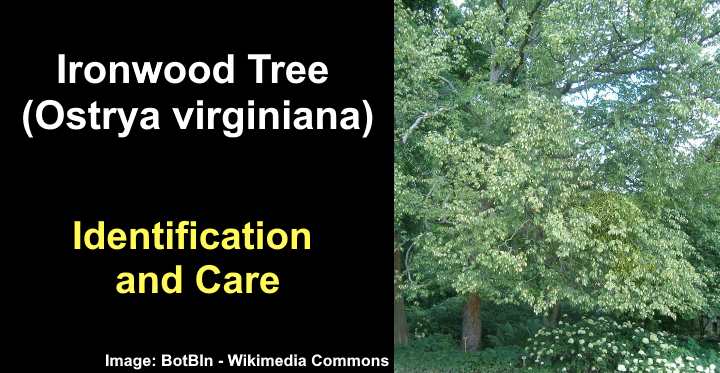
The ironwood tree (Ostrya virginiana) is a small deciduous understory tree. It is identified by its birch-like leaves, light brown shaggy bark, and yellowish-green flower clusters. Ironwood trees are attractive in the landscape with a pyramidal, rounded crown and their ability to grow in almost any location. As an understory tree, the ironwood performs well in deeply shaded conditions, and it also grows just as well in full sun.
Also called the American Hop Hornbeam, the ironwood is known for its incredibly robust, strong timber resulting from its slow growth. The attractive cold-hardy tree grows well on sloped areas, as well as rocky forests, compacted clay soil, and is relatively resistant to drought.
This article is a complete identification guide to the ironwood tree. Descriptions and pictures of ironwood leaves, bark, flowers, and fruit will help you identify it in the landscape. If you decide this tree is perfect for your garden landscape, there is a handy care guide at the end of the article.
Ironwood Tree (Ostrya virginiana) Facts
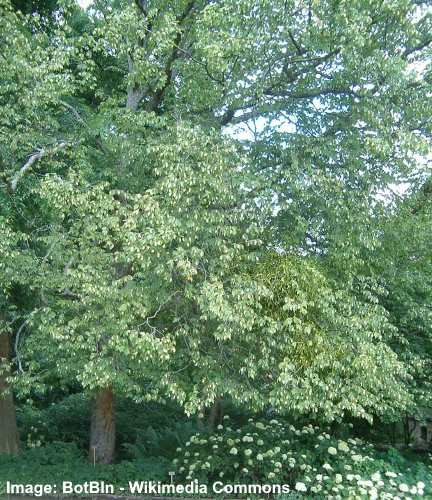
American hophornbeam (Ostrya virginiana)
Ironwood is classed as a small to medium-sized ornamental tree belonging to the genus Ostrya in the birch family Betulaceae. The ironwood tree grows 20 to 40 ft. (6 – 12 m) tall and up to 30 ft. (9 m) wide. It has a trunk diameter of up to 10” (25 cm), covered in peeling, shaggy bark.
Ironwood trees grow slowly, averaging around 12” (30 cm) or less per year. It will take 15 years to grow 10 to 15 ft. (3 – 4.5 m) tall. Young ironwoods have a typical pyramidal shape that gradually becomes more oval and rounded as it matures.
Ironwood trees thrive in USDA zones 3 to 9. The cold-hardy tree performs well in all growing conditions — from deep shade to full sun. As long as the soil is well-drained and not prone to flooding, ironwoods grow well in most soils.
An attractive feature of ironwood trees is their horizontal, drooping branches covered in serrated, ovate leaves. Immature trees have somewhat fuzzy branches that become smoother and gray as the tree matures.
The slow growth of ironwood trees is why the timber is so robust. Ironwood has one of the hardest woods of all the native North American trees. It’s harder than maple, white oak, hickory, elm, and birch trees. Because of this, the wood is used for making tool handles, fence posts, and mallets.
Other common names for ironwood tree refer to the tree’s strength or growth features. For example, the names American hophornbeam and wooly hop hornbeam refer to the hop-like fruit that the tree produces after flowering. It is also sometimes referred to as leverwood or hardhack.
Being a member of the birch family Betulaceae, the ironwood tree shares characteristics of birch and elm trees. Its leaves are lance-shaped with serrated margins like birch trees. Additionally, its spreading pyramidal to oval shape gives it the appearance of elm trees. However, ironwood trees are significantly smaller than elm and birch trees.
Ironwood Tree Flowers
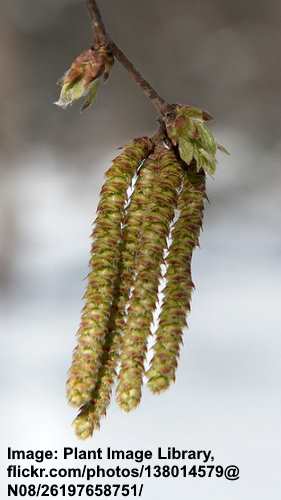
Ironwood tree flowers
Flowers on ironwood trees are in the form of dangling catkins — yellowish-green or reddish-brown drooping clusters. The tubular clusters measure around 3” (75 mm) long and grow in groups of up to four. Ironwood is a monoecious tree, meaning male and female flowers appear on the same tree.
Male ironwood flowers are yellowish-brown and appear as scaly bracketed spikes drooping from branches. On the other hand, female ironwood flowers are pale green flowering spikes standing erect on new twigs.
A feature of ironwood tree flowers is that the male catkins persist on the tree throughout winter.
Ironwood Tree Leaves
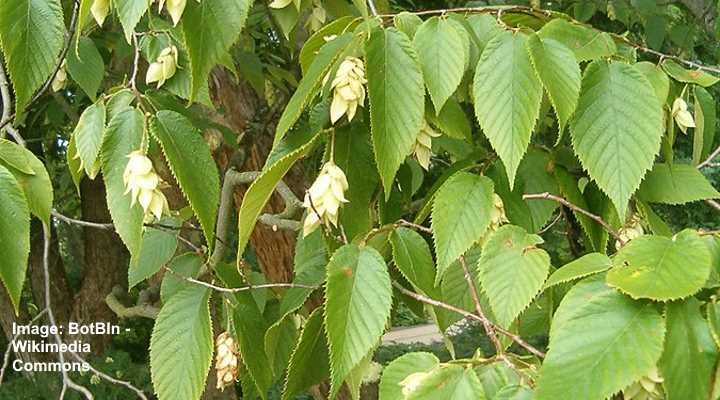
Ironwood tree leaves
Leaves on ironwood trees are light green, lanceolate shaped with double serrated margins and a fine fuzzy texture on the upper side. The oval-elliptic pointed leaves measure 3” to 6” (75 – 150 mm) long and 2” (50 mm) wide. The ironwood leaves are characterized by deep parallel ridges from the midrib to the edge.
Ironwood tree leaves are simple leaves that grow alternately on thin twigs. The pointed lance-shaped blades tend to be small further up the canopy.
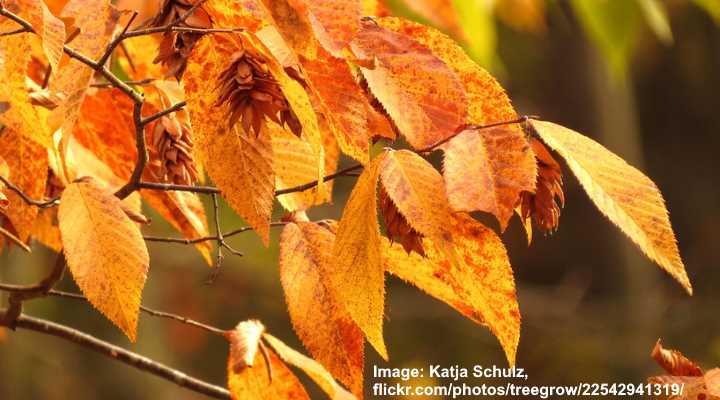
Ironwood leaves in autumn
It’s easy to mistake ironwood leaves for birch tree leaves. However, ironwood leaves turn an insignificant yellow color in the fall compared to vibrant golden-yellow birch leaves. Additionally, ironwood leaves usually drop earlier than birch tree leaves.
Ironwood Tree Bark
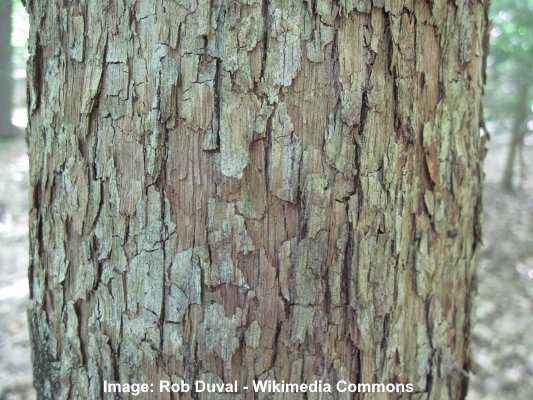
Ironwood tree bark
The bark covering the ironwood tree trunk is light brown and shaggy that develops into rectangular plates. The bark on young ironwood trees is relatively smooth with several lenticels. However, in time the bark becomes scaly and peels easily from the tree. Mature ironwood trees have grayish-brown loose scaly plates.
Ironwood Tree Seeds (Fruit)
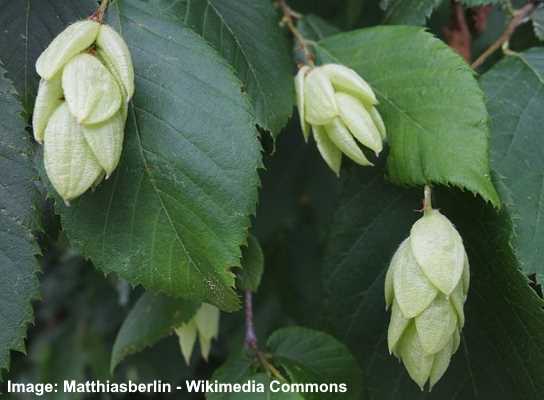
Ironwood tree fruit
The ironwood tree is identified by its hop-like fruit — clusters of seed-bearing pods of papery sacs, each containing a tiny, oval nutlet. The pendulous clusters of papery enclosures grow between 1” and 2” (25 to 50 mm) long. The seed clusters develop in summer and persist on the tree through winter.
Ironwood Tree Identification
The identifiable features of the ironwood tree are its light green, pointed, lance-shaped leaves with doubly-serrated margins, dangling copper-brown colored hop-like fruits, and light to dark brown shaggy, narrow strips of bark. Ironwood is a relatively small tree in a landscape compared to birch and elm trees.
Ironwood Trees in the Landscape
Ironwood tree is an attractive shade-tolerant tree, making it ideal for growing as an understory tree. The ironwood tree performs well in various moisture and soil conditions but grows best in well-drained soil in part sun. In the landscape, ironwood has a rounded canopy and slender, rough trunk.
Ironwood is an excellent tree to grow in urban and residential landscapes. The hardy tree copes well with various urban conditions, like pollution and compacted soils. This is one reason why it’s a popular street tree. In addition, the tree’s relatively small size makes it ideal for residential gardens to grow as a shade tree in a backyard or around patios, especially where space is restricted.
One reason to consider growing an ironwood tree is that it requires little pruning to maintain its shape. In addition, its robust branching system means that it’s resistant to breakage in high winds or under heavy ice or snow.
Where to Plant Ironwood Tree
Ironwood trees perform best planted in full sun to partial shade. However, as an attractive upright understory tree, it will also grow well in deep shade. Ironwoods also adapt well to varying soil conditions. Therefore, you can plant it in dry, gravelly soil or heavily compacted clay soil.
When planting an ironwood tree, the most critical growing consideration is that the soil drains well. Ostrya virginiana doesn’t like soggy roots, and it won’t grow well in areas prone to flooding.
Another consideration is its tolerance of salty conditions. Ironwood is intolerant of salt, so it shouldn’t be planted near roads that are heavily salted in the winter.
How to Plant Ironwood Tree
It’s best to plant ironwood as a nursery tree that has grown in a container. Ironwood trees are notoriously slow growers, and planting a tree from a nursery gives you a great head start.
To plant a potted Ostrya virginiana, prepare the location by digging a hole as deep as the root ball but three times as wide. Next, remove the tree from its pot and loosen the roots as much as possible. Then set it in the center of the hole, ensuring that the part where the trunk broadens to the roots (the tree flare) is slightly above ground level.
The next step is to half fill the hole with native soil, tamping the ground firmly as you backfill the spot. Then thoroughly water the roots to hydrate them and eliminate air pockets. Lastly, fill the hole up to the soil line, pressing down as you go.
After planting the ironwood tree, thoroughly water the ground and put a 2” to 3” (5 – 7.5 cm) layer of mulch over the root area. Mulching a newly-planted tree helps lock in moisture, prevents evaporation, and stops weeds from growing through.
Ironwood Tree (Ostrya virginiana) Care Guide
It’s easy to care for ironwood trees, as they can adapt to various environmental conditions. However, the iron-hard trees require specific care for the best results, especially during the first years after planting. On the other hand, well-established ironwood trees tolerate drought and require little maintenance.
How to Water Ironwood Trees
Established ironwood trees don’t require much watering for healthy growth. Typically, you can give the tree around 1” (25 mm) of water per week, as long as the top layer of soil dries out between watering. However, ironwood trees are relatively drought-tolerant trees and will withstand periods of dry conditions.
Regular watering is critical for the first two years after planting an ironwood tree. Regular root hydration helps to develop a healthy, robust root system. During the first two years, deeply water the tree twice a week, from spring through summer. In addition, it may be necessary to water the tree more frequently especially during dry weather.
Ironwood Tree Fertilization
Ironwood trees can benefit from regular fertilization to keep them healthy and prevent pest damage — however, it’s not usually required. You can use a nitrogen-rich fertilizer to promote green leafy growth. It’s essential to avoid excessive nitrogen in the soil as this could affect flower and seed production.
Generally, there is no need to amend the soil or apply fertilizer to newly-planted ironwood trees. This is because the salts in the fertilizer compound could burn the roots.
It’s good to note that ironwood trees typically grow well in average soil without adding fertilizers. The best advice is to work in some rotted manure or organic compost to the root area in spring. However, if you decide the tree requires additional nutrients, get a soil test done first to determine the type of tree fertilizer to use.
How to Prune Ironwood
Ironwood doesn’t require much pruning to develop a strong branching structure. While the tree is relatively young, you can remove some lateral branches to form a dominant central trunk. This is especially necessary with some ironwood trees that grow multiple stems. However, an established ironwood tree doesn’t need regular pruning.
As part of regular tree maintenance, it’s a good idea to inspect ironwoods annually in late fall after the leaves have dropped. Look for broken, dead, or diseased limbs, as well as branches that are rubbing together. You can remove those branches to encourage healthy growth and prevent disease.
Ironwood Propagation
Although stem cuttings are the most common method to propagate shrubs and trees, seed propagation is the preferred way to grow an ironwood tree. Ironwood seeds require warm stratification and cold stratification to germinate successfully.
It’s good to note that when handling ironwood seeds, you should wear gloves. The ornamental tree is also called the itchy tree because the seed clusters can cause itchy fingers — like after handling fiberglass insulation without protection.
How to Grow Ironwood Tree From Seed
Ironwood trees are relatively easy to grow from seed by sowing them directly in the ground in early fall.
Alternatively, you can collect the ripe seeds between late summer and early fall and dry them.
Ironwood seeds require 60 days of warm stratification followed by 120-140 days of cold stratification. This is necessary for successful germination. To grow Ostrya virginiana from seed, this is what you should do:
- Submerge the seeds in a jar of boiling water and leave them to soak for 24 hours.
- Put the seeds in a sealable (zip-lock) plastic bag filled with damp sphagnum moss.
- Put the seeds in a warm place that is between 68°F and 86°F (20°C – 30°C) for 60 days. Then, regularly check the seeds for mold and keep the soil slightly damp.
- After that, place the bag in a cool place that is 39°F to 41°F (4°C – 5°C) (like your refrigerator) for 120 days.
After stratifying the seeds, you can put the seeds in small pots filled with damp, well-draining potting soil to germinate using standard procedures.
How to Grow Ironwood Seedlings
To germinate stratified ironwood seeds, prepare a seed soil mix from 3 parts peat moss and one part perlite. Fill small individual pots with the potting mix and mist to moisten. Next, put a seed in each pot, about 0.25” (6 mm) under the surface, cover with plastic, and put in a bright, warm place out of direct sunlight.
Once the seeds germinate after a few weeks, place them in a brighter location where they get around 12 hours of light daily. After one month, you will need to transfer the ironwood seedlings to a larger pot. Then, you can plant them outdoors in the ground when the seedlings have grown about 15” to 20” (40 – 50 cm) tall.
Pests Affecting Ironwood Growth
A benefit of growing an ornamental ironwood tree in the landscape is that it is relatively pest-free. Healthy trees rarely suffer any damage from common tree bugs like aphids, scale insects, or leaf borers.
The only significant pest to affect ironwood tree leaves is the two-lined chestnut borer (Agrilus bilineatus). This slender black beetle can live and feed on the inner bark of ironwood trees. The beetle activity can result in defoliation. However, the best way to prevent this is to water the ironwood well during drought periods.
Diseases Affecting Ironwood Tree Growth
Ironwood is a robust, hardy tree, and typical tree diseases rarely affect its growth. Sometimes, canker diseases can cause individual branches to die back. However, it’s usually possible to avoid this by preventing the tree from getting stressed. So, water it well during dry weather.
Occasionally, foliar diseases like powdery mildew, leaf blister, and leaf spots can affect the tree leaves. However, they never significantly harm the tree’s health, and generally, there is no need to control them.
Related articles:
